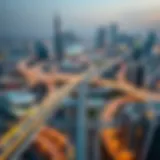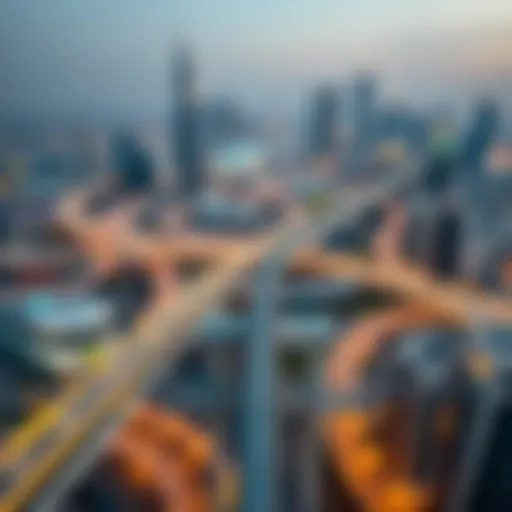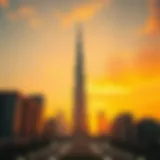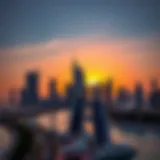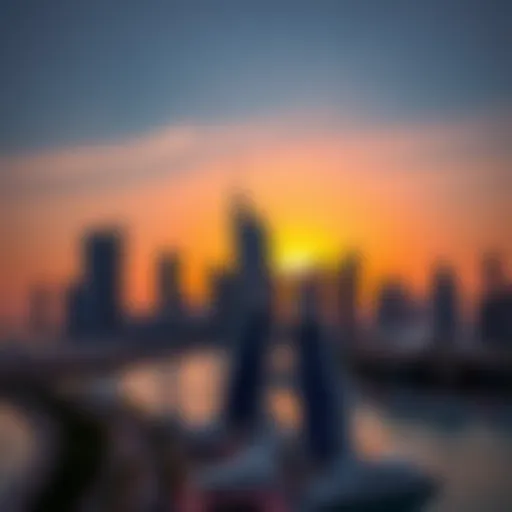Museum of the Future: Shaping Dubai's Real Estate Trends
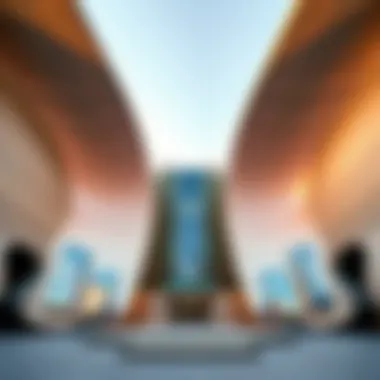
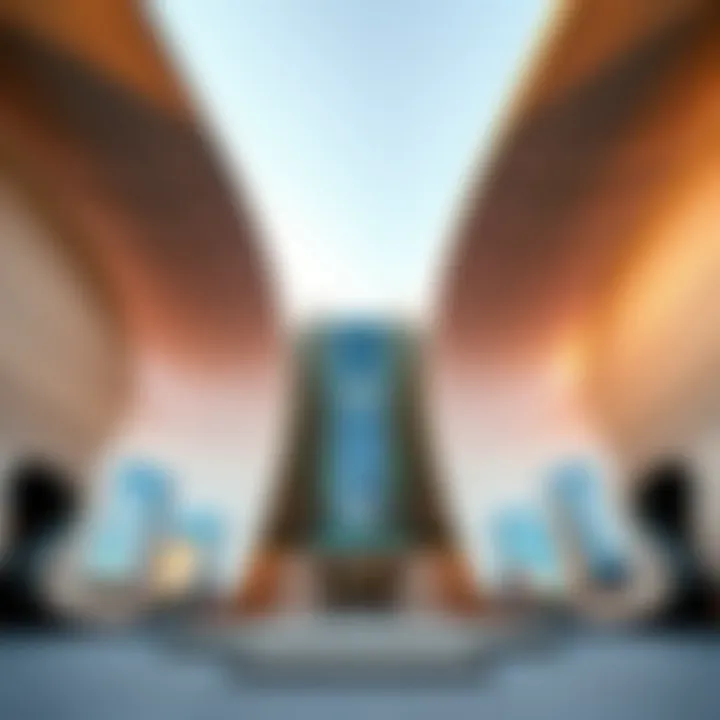
Intro
The Museum of the Future stands as a striking emblem of what innovation can achieve within the sleek, modern landscape of Dubai. Not just an architectural marvel, it represents a convergence of creativity and technology, showcasing futuristic ideologies and aspirations. The messages etched on its exterior serve as both inspiration and a roadmap for Dubai's urban evolution, directly impacting the real estate landscape of this vibrant city.
As the lines between imagination and reality blur, investors, agents, and analysts are prompted to explore how the essence of the Museum of the Future encapsulates the socio-economic shifts in Dubai. With this focus, we dive deep into the market trends and investment opportunities spurred by the museum's symbolic presence, illuminating what they mean for the evolving urban tapestry and the choices made by buyers and stakeholders in real estate.
Foreword
The Museum of the Future serves as a beacon for innovation, providing rich insights that are crucial for understanding Dubai's evolving real estate landscape. As Dubai pursues ambitions to be the leading tech and innovation hub, the museum closely associates with these aspirations, capturing both local and global interest. This rapport is particularly relevant for investors, real estate agents, and buyers who are observing how the pulse of urban development beats alongside technological progress.
The museum is not just an architectural marvel; rather, it symbolizes the aspirations of a city steadily marching toward a brighter future. Observing its influence helps in navigating the intricate dynamics that shape the real estate market. Being aware of the broader implications stemming from the museum's initiatives can shift strategies, not just for property investment, but also for urban development and community engagement.
Furthermore, the inscriptions adorning the museum’s exterior add layers of meaning that are integral to understanding societal aspirations. Each phrase tells a story about growth, interconnectedness, and sustainability, which resonate deeply with potential buyers and investors scouting for opportunities in areas undergoing transformation.
In short, understanding the importance of the Museum of the Future and its inscriptions provides critical insights that can inform decision-making in real estate activities. This section lays the groundwork for exploring the profound implications of architectural innovation and urban aspirations, bridging the gap between tradition and modernity in the Dubai real estate market.
The Inscriptions Unpacked
Key Messages and Themes
The Museum of the Future is not just an architectural marvel but a canvas that communicates deeper meanings through its inscriptions. Each word etched into its exterior serves as a reflection of the aspirational spirit that characterizes Dubai. Key messages revolve around themes of innovation, sustainability, and a global outlook. These inscriptions resonate with the ethos of a city that embraces diversity, aiming to bring together cultures through shared knowledge and future-oriented thinking. They encourage visitors and residents alike to ponder the impact of their actions on the planet and society at large.
The choice of phrases inscribed is deliberate. They are curated to spark thought, fostering dialogues about challenges and dreams for tomorrow. The messages allude to the realities of modern life—like the need for eco-friendly solutions and the importance of connectivity in an increasingly globalized world. In turn, they compel potential investors and buyers to recognize that real estate in Dubai is not merely about acquiring property; it’s about being part of a larger narrative of progress and possibility.
Cultural Significance
The cultural significance of the inscriptions cannot be understated. They are a vibrant tapestry woven from the rich history of the UAE, intertwined with advances in technology and urban development. This blend embodies Dubai's ambition as a city that respects its roots while propelling itself into the future. The way they encapsulate local values while drawing inspiration from worldwide philosophies shows how interconnected our lives have become.
For instance, phrases that highlight collaboration or resilience resonate with both foreign investors and local stakeholders. They serve as a bridge, linking diverse communities in a shared pursuit of progress. Investors looking at Dubai's real estate landscape must pay close attention to the cultural narratives depicted here, as they dictate not just the aesthetic appeal of the area but also the market's potential. The sentiments reflected in these inscriptions can enhance property value, as buyers find meaning in places that resonate with their own ideologies and aspirations.
In summary, the inscriptions are not mere decorative elements; they are pivotal in framing the context within which Dubai's real estate operates. They engage on levels that are emotional and intellectual, shaping the perception of potential investors while highlighting broader societal trends.
"A city is not just what it appears on a map; it's the sum of its stories, aspirations, and cultural dialogues."
The inscriptions at the Museum of the Future encapsulate this sentiment beautifully.
The Museum's Role in Urban Development
The Museum of the Future is not just an architectural marvel but a pivotal element in the evolving urban landscape of Dubai. It serves as a catalyst for inspiration and innovation, reflecting the city’s ambitions toward becoming a global hub for technology and culture. Its design and purpose present unique considerations that resonate across various sectors, notably real estate.
One noteworthy aspect of the Museum's influence is its ability to attract significant attention both locally and internationally. This attraction draws visitors, investors, and futurists alike to experience the cutting-edge exhibits and futuristic concepts. Effectively, the Museum acts as a beacon—shining a light on what is possible and encouraging future advancements in urban stylistics and infrastructure.
Furthermore, urban spaces surrounding the Museum are being developed to complement its progressive vision, reimagining how city dwellers interact with their environment. This focus on enhancement isn't limited to just tourism; it reflects an essential shift towards better accessibility, sustainability, and the merging of technology with daily life.
Inspiration for Future Projects
The Museum of the Future inspires numerous projects that are currently taking shape across Dubai. Developers and architects are increasingly approaching design concepts that prioritize creativity and sustainability—elements that the Museum embodies.
- Community-Centric Designs: Inspired by the interplay of technology and culture, more projects are centering around creating spaces that enhance community engagement. This is seen in the planning of communal areas that foster social interaction, making neighborhoods more cohesive.
- Technological Innovation: As the Museum integrates advanced technologies to provide interactive experiences, similar technologies are being explored in residential and commercial developments, pushing the envelope in user engagement and functionality.
- Aesthetic Appeal: The Museum’s striking design has led to a rise in demand for unique architectural features in new projects, stirring a trend of creative expression in building facades and interiors.
"Projects that draw inspiration from the Museum showcase a shift in priorities—from purely functional to deeply experiential, marrying form with function in unprecedented ways.”
Implications for Real Estate Trends
The presence of the Museum fundamentally shifts real estate trends in several significant ways. As a cultural landmark, its effects on the local property market can not be understated, offering insights into future investment opportunities.
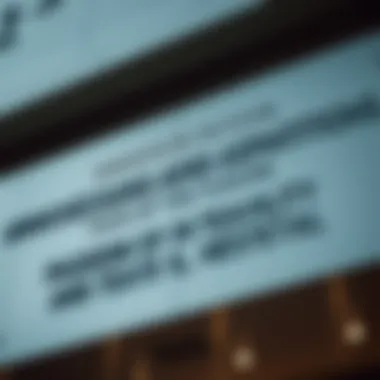
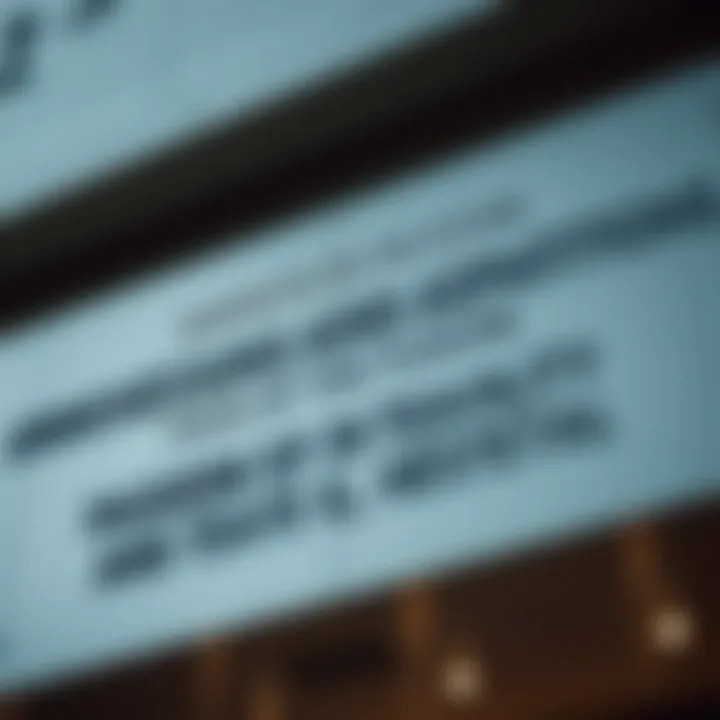
- Increased Property Values: Properties in proximity to the Museum are observing increased values. Investors recognize the potential appreciation fueled by the cultural enrichment and foot traffic generated by the Museum.
- Shift in Buyer Preferences: Potential buyers are increasingly drawn to properties that offer easy access to innovative spaces. The preference is shifting towards urban living that emphasizes both proximity to cultural landmarks and the integration of modern amenities.
- Development of Emerging Neighborhoods: Areas surrounding the Museum are undergoing transformations that highlight mixed-use developments, blending residential, commercial, and cultural spaces. These developments appeal to a diverse array of residents and investors, moving away from traditional zoning practices.
The architectural and cultural significance of the Museum of the Future underscores a transformative period in Dubai’s urban development. It propels a new narrative for how design, interaction, and technology can harmonize, creating a lasting legacy that will undoubtedly shape Dubai's real estate landscape for years to come.
Architectural Innovation
Architectural innovation serves as a beacon of progress within Dubai's urban landscape, exemplified poignantly by the Museum of the Future. This structure is not merely a building; it’s a manifesto of what is achievable when design meets ambition. The Museum ignites conversations about the roles of architecture in shaping our everyday lives and, by extension, the real estate market.
In today's fast-paced world, innovative architecture have become critical in attracting investments and enhancing the livability of urban areas. The Museum of the Future showcases how imaginative design can be harmoniously integrated with futuristic technologies, transforming the skyline and signaling that Dubai is indeed a city that dreams big.
Design Elements Reflecting Future Aspirations
The architecture of the Museum is nothing short of a visual symphony. It melds shapes and forms that evoke both curiosity and admiration. The striking torus-shaped building, with its seamless blend of glass and steel, reflects contemporary aspirations toward transparency, lightness, and openness. Such imaginative structures contribute to the narrative that Dubai is not just a city of skyscrapers but a center of pioneering design movements.
- Fluidity of Design: The graceful curves symbolize dynamism and adaptability, much like the city itself.
- Symbolic Inscriptions: Engravings on the structure communicate future-centric messages, speaking to innovation and humanity’s quest for improvement.
- Public Engagement: The design invites public interaction, allowing visitors to engage with the building's exterior and reflects a broader vision of participation in societal evolution.
These design elements not only attract tourists but also serve potential investors looking for projects that offer not just functionality but also an aesthetic that resonates with modern aspirations.
Sustainability and Technology Integration
Sustainability is no longer an option for modern architectural practices; it is a necessity. The Museum of the Future is an exemplary model of how to integrate advanced technology with eco-conscious design. The building employs cutting-edge materials and systems that minimize energy use while maximizing comfort and utility.
- Renewable Energy Solutions: Solar panels and energy-efficient systems significantly reduce the carbon footprint of the Museum.
- Water Conservation Technologies: Innovative rainwater harvesting and recycling systems ensure that natural resources are utilized sparingly.
- Smart Building Features: Automation systems for lighting, temperature control, and security seamlessly weave technology into the visitor experience, enhancing both safety and comfort.
The fusion of sustainability and technology does more than just set the stage for a better environment; it paves the way for intelligent investments in real estate around durability and forward-thinking design principles. As Dubai continues to expand, developments inspired by such innovative architecture will likely become the norm, setting new standards for what real estate can and should represent in the evolving urban tapestry.
"The Museum of the Future stands as a testament to what can be achieved when design unites with vision—two essential ingredients for shaping the future of Dubai."
For more insights into Dubai's architectural marvels, visit Wikipedia or Britannica.
Impact on Real Estate Investment Strategies
The Museum of the Future stands not just as a marvel of architecture but also as a cornerstone for shaping the real estate landscape in Dubai. Its influence on investment strategies cannot be overstated. Investors today are navigating a complex interplay of innovation, sustainability, and urban identity, and the museum encapsulates these themes in profound ways. When looking at the broader picture, understanding these dynamics can guide investors in making informed decisions about where and how to allocate resources.
Emerging Neighborhoods Around the Museum
The areas surrounding the Museum of the Future are transforming at a rapid pace. One need only look around to see the sprawl of new residential and commercial developments sprouting like daisies in spring. These neighborhoods are becoming hotbeds for prospective buyers and investors, thanks to a mix of unique selling propositions that include proximity to the museum and futuristic urban designs.
For instance, the Al Wasl district is attracting attention with its sleek cafes and boutique shops. Plus, it’s convenient for families looking to settle down while being close to educational institutions and healthcare facilities. Here’s some key aspects about these emerging neighborhoods:
- Proximity to Innovation: Living near the Museum of the Future places residents at the center of innovation, fostering a culture that values creativity and modernity.
- Urban Amenities: New developments are prioritizing mixed-use spaces, blending living, shopping, and recreational facilities.
- Increased Property Values: As more people flock to the region for its modern offerings, property values are on an upward trajectory, presenting a lucrative opportunity for investment.
In this context, neighborhoods such as Zabeel and Downtown Dubai are not merely geographical markers. They symbolize a lifestyle aspiration for many. Investors keen on capitalizing on the future should consider these areas as prime real estate locations.
Evolving Buyer Preferences
As we navigate through the shifting sands of the real estate market, it’s clear buyer preferences are evolving. Once, the emphasis was largely on location and square footage. Now, buyers actively seek out innovative features, sustainability, and community aspects that enhance their living experience. The Museum of the Future embodies this shift, acting as a beacon for what modern buyers value today.
Here are several trends influencing buyer behavior:
- Technology Integration: Modern homes that incorporate smart technologies are increasingly appealing. Buyers want homes that are not just living spaces but also tech-savvy environments that support convenience and efficiency.
- Sustainability Practices: With rising awareness about climate change, many buyers prioritize eco-friendly features, such as energy-efficient appliances and sustainable building materials.
- Community-Oriented Design: There’s a palpable demand for properties that foster community interaction. Buyers seek neighborhoods where they can connect with like-minded individuals, a trend that is particularly pronounced in areas surrounding innovative hubs like the Museum of the Future.
In summary, the Museum of the Future is a linchpin, impacting not only the market dynamics of real estate but also the cultural landscape shaping Dubai. Investors and buyers should remain astute to these emerging patterns, as they reflect broader shifts in our aspirations and lifestyles.
Balancing Tradition and Innovation
In a rapidly developing landscape like Dubai, the idea of balancing tradition and innovation becomes essential. Traditional architecture and modern design can coexist, yielding spaces that are not only aesthetically pleasing but also enriched with cultural significance. The Museum of the Future stands as a shining example of this balance, prompting the exploration of how cultural heritage can inform and elevate modern developments.

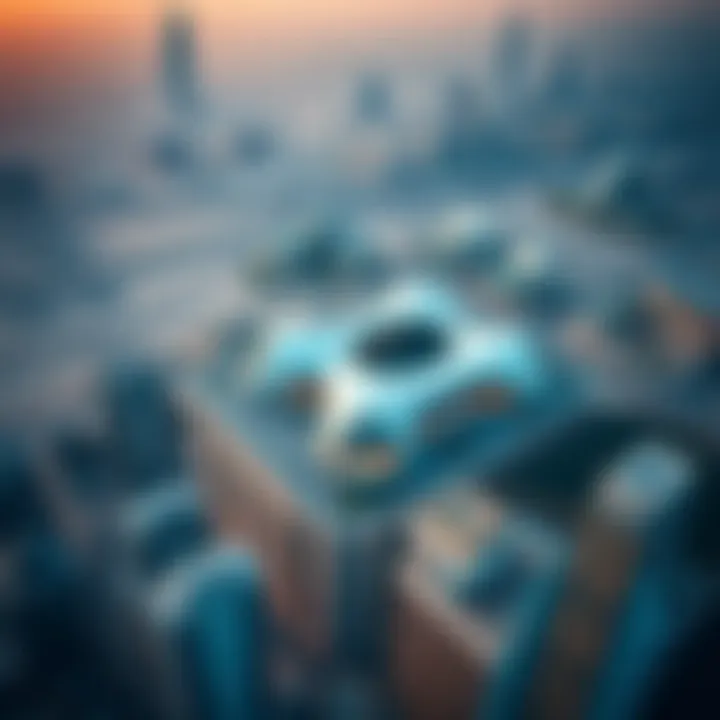
Cultural Heritage in Modern Developments
Cultural heritage plays a crucial role in shaping a city’s identity. Incorporating traditional designs and practices into modern architecture is more than just a nod to the past; it connects generations and fosters a sense of belonging among residents. Consider the iconic Burj Khalifa, whose design is inspired by Islamic architecture. Such influences are pivotal—they underscore Dubai’s cultural narrative while enabling the city to project a forward-thinking image.
Moreover, balancing these elements is not without its challenges. The risk of erasing cultural identity in favor of modernity is ever-present, making the task of integrating heritage an imperative one. Developers need to keep in mind the local customs, environmental concerns, and community values when integrating these traditional elements. Fostering community engagement in the design process also aids in ensuring that modern structures resonate with the local population.
> "The future of urban living thrives on the synergy between the ticking watch of history and the bold leaps of innovation."
For instance, the Dubai Creek Harbour project showcases how heritage can blend seamlessly with cutting-edge design. Here, the inspired design elements of historic Dubai are evident, creating a community that celebrates its roots while embracing modern conveniences. Locations rich in history offer an excellent backdrop for developments that thrive on a deeper narrative, making them appealing not just to investors but to potential buyers looking for more than just a living space.
Case Studies of Successful Integration
Many projects in Dubai demonstrate the successful integration of tradition and innovation. The Al Fahidi Historical Neighborhood, often considered a living museum, embodies this integration perfectly. The narrow lanes and wind towers common in Emirati architecture highlight the deep respect for history, while the introduction of art galleries and designer boutiques nods to contemporary needs and tastes. This creates a dynamic area where residents and visitors can enjoy both the old and the new.
In contrast, the Dubai Design District (d3) offers an environment designed to inspire creativity and innovation, but it acknowledges its roots in Emirati culture through thoughtful architectural nods. The spaces within d3 incorporate Middle Eastern design elements while providing a platform for contemporary art and fashion. This encourages a fusion of cultures and ideas, feeding into the larger narrative of Dubai as a multi-faceted metropolis.
On an even grander scale, the upcoming Dubai Expo 2020 site aims to depict the balance of tradition and progress under the theme of Connectivity, Sustainability, and Opportunity. Hundreds of pavilions from around the world will display innovative designs, many incorporating local traditions and practices, thus fostering a sense of global unity and cultural appreciation.
Ultimately, as developments continue to rise across Dubai’s skyline, the intention should remain clear: to respect heritage while boldly stepping into the future. This balance will not only enhance Dubai’s architectural landscape but will also deepen the connections residents and visitors feel to this remarkable city.
For further reading, consider exploring:
- Cultural Heritage and Urban Development
- Architectural Modernism vs. Tradition
- Insights from the Dubai Culture and Arts Authority as they continue to promote the rich cultural tapestry of Dubai.
Visitor Experience and Engagement
The exploration of visitor experience and engagement at the Museum of the Future carries significant weight in understanding its broader implications for Dubai's real estate landscape. This museum, unlike many traditional institutions, operates as an interactive space that invites its audience into a dialogue. It transcends the mere act of viewing artifacts or displays; it creates an immersive environment where learning becomes an experience. As technology becomes increasingly integrated into public spaces, how visitors interact within these environments can shape perceptions and, consequently, influence real estate trends around the museum.
A critical aspect of the visitor experience is the interactive elements incorporated throughout the museum. The museum is not just a showcase of the future but a platform where ideas are exchanged and experiences are shared. This engagement is amplified by the use of cutting-edge technology—augmented reality, artificial intelligence, and digital storytelling allow visitors not merely to observe but to participate in the narrative of the future. Such immersive experiences provide insights into what inhabitants of Dubai may seek in real estate: spaces that foster connectivity, creativity, and community.
Ultimately, the layers of engagement manifest a multifaceted environment where feedback loops are generated, allowing for a clear understanding of visitor desires and expectations. While traditional museums often serve a passive role, the Museum of the Future flips this script, resulting in a vibrant, dynamic setting that reflects the needs of a rapidly developing urban landscape.
Creating an Interactive Environment
A key feature of the Museum of the Future lies in its commitment to creating an interactive environment that captivates its visitors. Unlike other museums where one observes passively, this museum invites guests to dive into various experiences. Here, they can explore various future scenarios, such as extraterrestrial travel or digital cities, through a tactile and sensory approach.
The architecture itself beckons engagement. Its design, which includes flowing forms and a lack of visible supports, promotes exploration. Visitors wander through spaces that surprise and delight, sparking curiosity.
- Utilization of Technology: Immersive installations are complemented by advanced technologies, like interactive displays and virtual reality experiences that provide deeper understanding of concepts.
- Workshops and Activities: The museum often hosts hands-on workshops where visitors can express their own ideas on concepts of future living and urban planning. This provides a fertile ground for ideas that might influence the architectural direction of nearby real estate developments.
Through such immersive interactions, the Museum of the Future not only redefines how people engage with concepts but also serves as a commercial touchstone that guides real estate developers.
Feedback and Future Prospects
Feedback gathered from the interactions within the museum plays a pivotal role in shaping future engagements and developments. In a city that values progress, the feedback loops formed at the museum can provide crucial data points for understanding visitor preferences and expectations.
- Harnessing Visitor Insights: The museum's willingness to adapt and create new experiences based on visitor comments can create a reservoir of insights that reflect broader consumer trends. Developers aiming to invest in areas surrounding the museum can benefit from understanding what works and what does not.
- Potential Urban Development: These insights suggest a trend towards community-centric real estate that caters not just to affluent buyers but to that broader public voice. A living, breathing urban landscape that listens, learns, and evolves as per the requests of its users.
Given Dubai's aggressive push towards innovation, the Museum of the Future stands to become a testbed for ideas that, if successful, could be mirrored throughout the city's burgeoning ecosystems. The continuum of feedback fosters a cycle of improvement and innovation that directly impacts how real estate is envisioned and developed in the vicinity.
"The Museum of the Future represents not just an architectural marvel; it epitomizes a shift in cultural dialogue that weaves together innovation and community engagement."
Government Initiatives and Support
In Dubai, government initiatives play a crucial role in shaping the real estate landscape, especially in relation to innovative projects like the Museum of the Future. The museum not only stands as a beacon of progress but also reflects the broader aspirations of a city that aims to position itself at the forefront of technological and urban development. With the government’s unwavering support, the real estate sector witnesses transformations that are as profound as they are necessary. This support manifests in various forms: policies that foster innovation, infrastructural investments, and incentives that entice investors and developers.
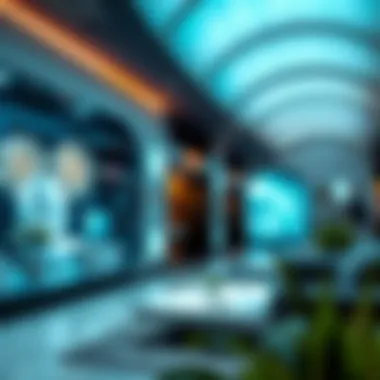
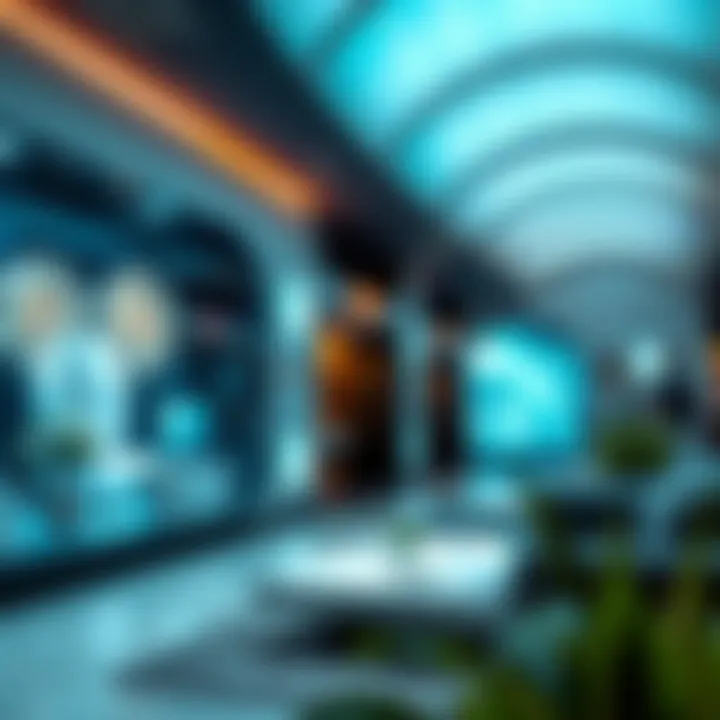
Policies Supporting Innovation and Development
The policies the government has woven into the fabric of Dubai’s real estate sector are specifically tailored to promote innovation. For instance, the Dubai 2040 Urban Master Plan emphasizes sustainable urban expansion along with the integration of smart technologies in new developments.
- Focus on Sustainability: Initiatives geared towards sustainable practices include green building policies and eco-friendly construction guidelines. This not only aligns with global sustainability goals but also enhances the appeal of the market for a more environmentally-conscious populace.
- Technological Integration: The government facilitates partnerships between technology firms and real estate developers, advocating for smart city concepts that enhance the living environment in urban settings. The projects initiated under this policy aim to utilize AI and IoT to streamline services and improve the overall quality of life.
- Infrastructure Development: Perhaps one of the most impactful areas of governmental support includes the enhancement of infrastructure. Transportation networks, utilities, and community amenities are consistently upgraded to ensure they are in step with current advancements and future visions.
These initiatives create a fertile ground for innovative real estate practices. Developers are thus encouraged to leap into the future, becoming pioneers in a rapidly changing environment.
Investment Incentives for Real Estate
To further stimulate investment in the real estate sector, the government orchestrates numerous incentives that resonate well with both local and foreign investors. These incentives are strategically designed to make investing in Dubai real estate seem not just feasible, but highly attractive.
- Tax Benefits: One of the key lures is the absence of both income tax and capital gains tax on property investments, making it a no-brainer for many investors. This financial friendly climate acts like sweet nectar to bee-like investors who flock to the blossoms of opportunity.
- Freehold Property Options: The availability of freehold properties allows foreign nationals to own land and property outright, an attractive proposition that further encourages a diverse investor base. This has tremendously augmented the appeal of real estate in Dubai, opening doors to international buyers who previously felt deterred.
- Flexible Financing: The government also collaborates with financial institutions to provide favorable financing options. Various mortgage schemes with low-interest rates are available, allowing a broader range of individuals to step onto the property ladder.
Ultimately, the government’s commitment to fostering a supportive environment is crucial to nurturing a robust real estate sector that can adapt to both local and international market demands. These initiatives and incentives not only encourage current investments but also lay the groundwork for future developments that are aligned with the innovative spirit represented by the Museum of the Future.
"Dubai's vision rests on transformative initiatives, ensuring real estate isn't just about buildings but about creating a sustainable, innovative future."
While the future may be hard to predict, with the right support, it undoubtedly appears bright for Dubai's real estate landscape.
Future Trends in Dubai’s Real Estate Market
The transformation of Dubai’s real estate market is as dynamic as the city itself. With the advent of landmarks such as the Museum of the Future, which serves as a beacon of innovation, the realm of real estate has grown increasingly complex and fascinating. Understanding the future trends in this sector isn't just for those with a seat at the investment table; it has implications for urban dwellers, corporate stakeholders, and government policy-makers alike.
Predictions based on Current Developments
As we gaze into the crystal ball, several threads of thought weave together to form a pattern in Dubai's real estate narrative. The trends that seem to emerge are indicative of various socio-economic shifts, technological advances, and lifestyle changes. For instance:
- Rise of Smart Living: The integration of smart technology into residential properties will continue to surge. Featuring technologies such as automated home systems and energy-efficient appliances, these smart living spaces resonate with the sustainability ethos epitomized by the Museum of the Future. This trend is not merely cosmetic; it directly affects property values as tech-savvy residents seek out modern conveniences.
- Co-Working Spaces: With the remote working culture gaining traction, demand for flexible workspaces is anticipated to climb. Investors should pay attention to areas experiencing a rise in co-working spaces, as these will attract millennial professionals seeking a work-life balance.
- Mixed-Use Developments: There's an increasing preference for mixed-use developments that combine residential, commercial, and recreational spaces. These projects foster community and convenience, enhancing property attractiveness and, subsequently, the potential for lucrative returns.
In short, the trends point to a demand for properties that align not only with contemporary living standards but also with broader societal needs and technological advancements.
Opportunities for Investors and Buyers
For those who keep a keen eye on the horizon, Dubai’s evolving real estate landscape presents a plethora of opportunities:
- Emerging Neighborhoods: Areas such as Dubai Creek Harbour and Dubai South have become noteworthy. With investors increasingly focusing on these regions, early adopters can benefit from property price appreciation.
- Sustainability Investments: Given the global shift towards green living, there's a strong market for eco-friendly developments. Investors seizing opportunities in projects designed with sustainable principles in mind can not only contribute to environmental goals but also see their investments flourish in value.
- Leverage Government Incentives: The Dubai government has been supportive of real estate growth through various incentives. Keeping track of policies and investment funds can uncover advantageous options for both established investors and newcomers.
In essence, for investors and buyers ready to take the plunge, the landscape is ripe for exploration, driven by innovation and community-oriented approaches. This evolving real estate environment not only engages the current market trends but sets the stage for future developments aligned with the visionary spirit epitomized by the Museum of the Future.
End
The conclusion of this exploration takes on heightened significance, as it encapsulates the essence of how the Museum of the Future not only symbolizes innovation but also profoundly shapes Dubai's real estate landscape. Discussing this topic sheds light on several core elements that are crucial for various stakeholders in the real estate market, such as developers, investors, and property buyers.
Summarizing Key Insights
First and foremost, the Museum of the Future stands as a testament to the kind of forward-thinking architecture that Dubai is known for. The symbolic nature of its design reflects a blend of art and technology, serving as an inspiration for both new developments and renovations in the vicinity. Its inscriptions provide a philosophical backdrop, guiding present and future urban design in ways that cater to current lifestyles while considering environmental sustainability—a theme that resonates deeply with today's discerning buyers.
Moreover, key insights from its architectural and thematic elements illuminate the kinds of investments that are likely to yield fruitful returns. Properties surrounding the museum are expected to see increased interest, as demand shifts towards modern living spaces that prioritize innovation and engagement with culture. Investors and buyers must keep their ears to the ground to seize upon these evolving trends.
Here are some primary takeaways:
- Cultural Reflection: The connection between cultural heritage and modern innovation opens doors for successful real estate endeavors.
- Investor Responsibility: Real estate investors need to be proactive in understanding these shifts to make informed decisions.
- Community Engagement: Properties and developments that allow for community interaction will likely see more favorable outcomes.
Final Thoughts on Future Development in Dubai
Looking toward the horizon, the implications of what has been discussed stretch beyond mere architectural beauty. They delve into a kind of urban philosophy that ties together the city's past, present, and its ambitious future. As development continues to unfold around the Museum of the Future, it is imperative that the principles of sustainability and technological integration remain at the forefront of Dubai’s real estate strategy.
A few considerations moving forward include:
- The potential rise in boutique and mixed-use developments that cater to urban dwellers seeking vibrant, multifunctional spaces.
- A rethink of zoning laws that incorporate green spaces and communal areas, directly leading to a healthier urban ecosystem.
- Increased collaboration between governmental bodies and private investors to leverage the museum's symbolic power for wider economic benefits.
In summary, Dubai's trajectory in real estate investment, guided in part by the Museum of the Future, suggests a community that prioritizes innovative living while respecting its rich cultural tapestry. For anyone involved in the real estate sector—whether as an investor, agent, or buyer—the opportunities are profound and worthy of careful consideration.




